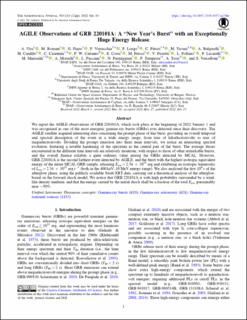AGILE Observations of GRB 220101A: A "new Year's Burst" with an Exceptionally Huge Energy Release
| dc.contributor.author | Ursi, A. | |
| dc.contributor.author | Romani, M. | |
| dc.contributor.author | Piano, G. | |
| dc.contributor.author | Verrecchia, F. | |
| dc.contributor.author | Longo, F. | |
| dc.contributor.author | Pittori, C. | |
| dc.contributor.author | Tavani, M. | |
| dc.contributor.author | Bulgarelli, A. | |
| dc.contributor.author | Cardillo, M. | |
| dc.contributor.author | Casentini, C. | |
| dc.contributor.author | Cattaneo, P.W. | |
| dc.contributor.author | Costa, E. | |
| dc.contributor.author | Feroci, M. | |
| dc.contributor.author | Fioretti, V. | |
| dc.contributor.author | Foffano, L. | |
| dc.contributor.author | Lucarelli, F. | |
| dc.contributor.author | Marisaldi, Martino | |
| dc.contributor.author | Morselli, A. | |
| dc.contributor.author | Pacciani, L. | |
| dc.contributor.author | Parmiggiani, N. | |
| dc.contributor.author | Tempesta, P. | |
| dc.contributor.author | Trois, A. | |
| dc.contributor.author | Vercellone, S. | |
| dc.date.accessioned | 2023-03-17T12:42:35Z | |
| dc.date.available | 2023-03-17T12:42:35Z | |
| dc.date.created | 2022-10-17T18:30:42Z | |
| dc.date.issued | 2022 | |
| dc.identifier.issn | 0004-637X | |
| dc.identifier.uri | https://hdl.handle.net/11250/3059024 | |
| dc.description.abstract | We report the AGILE observations of GRB 220101A, which took place at the beginning of 2022 January 1 and was recognized as one of the most energetic gamma-ray bursts (GRBs) ever detected since their discovery. The AGILE satellite acquired interesting data concerning the prompt phase of this burst, providing an overall temporal and spectral description of the event in a wide energy range, from tens of kiloelectronvolts to tens of megaelectronvolts. Dividing the prompt emission into three main intervals, we notice an interesting spectral evolution, featuring a notable hardening of the spectrum in the central part of the burst. The average fluxes encountered in the different time intervals are relatively moderate, with respect to those of other remarkable bursts, and the overall fluence exhibits a quite ordinary value among the GRBs detected by MCAL. However, GRB 220101A is the second farthest event detected by AGILE, and the burst with the highest isotropic equivalent energy of the entire MCAL GRB sample, releasing Eiso = 2.54 × 1054 erg and exhibiting an isotropic luminosity of Liso = 2.34 × 1052 erg s−1 (both in the 400 keV–10 MeV energy range). We also analyzed the first 106 s of the afterglow phase, using the publicly available Swift-XRT data, carrying out a theoretical analysis of the afterglow, based on the forward shock model. We notice that GRB 220101A is with high probability surrounded by a wind-like density medium, and that the energy carried by the initial shock shall be a fraction of the total Eiso, presumably near ∼50%. | en_US |
| dc.language.iso | eng | en_US |
| dc.publisher | IOP | en_US |
| dc.rights | Navngivelse 4.0 Internasjonal | * |
| dc.rights.uri | http://creativecommons.org/licenses/by/4.0/deed.no | * |
| dc.title | AGILE Observations of GRB 220101A: A "new Year's Burst" with an Exceptionally Huge Energy Release | en_US |
| dc.type | Journal article | en_US |
| dc.type | Peer reviewed | en_US |
| dc.description.version | publishedVersion | en_US |
| dc.rights.holder | Copyright 2022 The Author(s) | en_US |
| dc.source.articlenumber | 214 | en_US |
| cristin.ispublished | true | |
| cristin.fulltext | original | |
| cristin.qualitycode | 2 | |
| dc.identifier.doi | 10.3847/1538-4357/ac746c | |
| dc.identifier.cristin | 2062221 | |
| dc.source.journal | The Astrophysical Journal (ApJ) | en_US |
| dc.identifier.citation | The Astrophysical Journal (ApJ). 2022, 933 (2), 214. | en_US |
| dc.source.volume | 933 | en_US |
| dc.source.issue | 2 | en_US |

